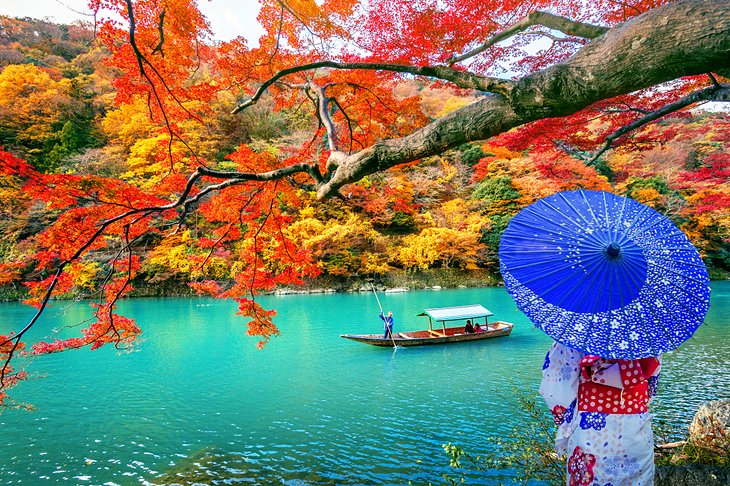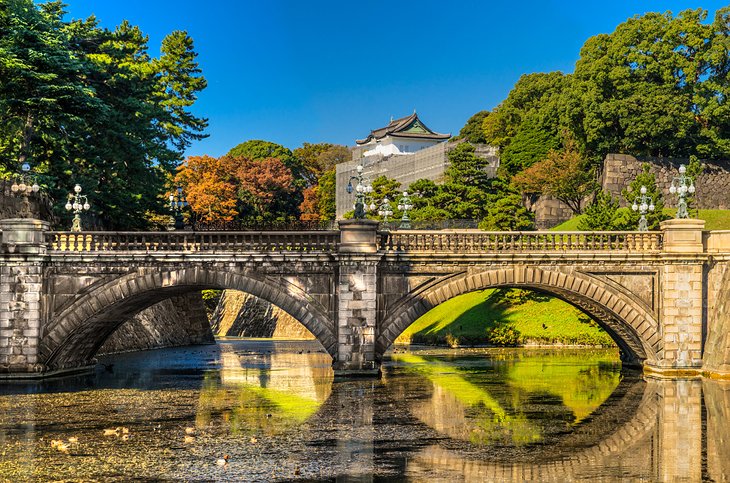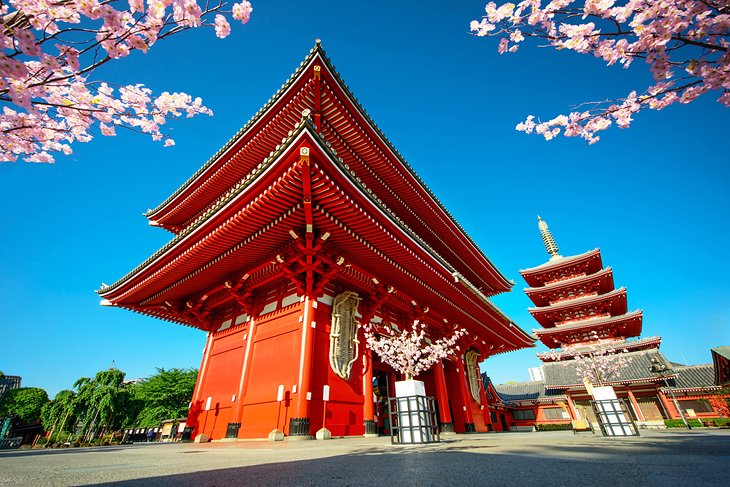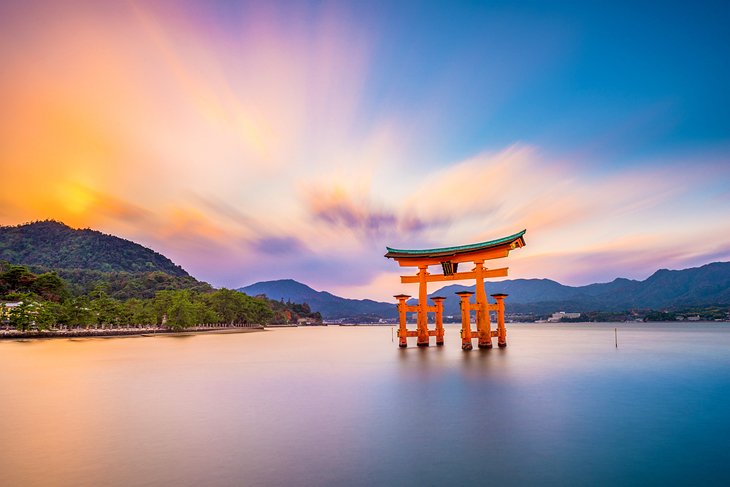Despite its small size, Japan experiences almost every kind of weather you could imagine – from rainy typhoon seasons to snowy winters to hot humid summers. Whether you want to ski, hike, or explore the city, Japan has much to offer – and a perfect season for each of these activities.
For most tourists interested in sightseeing, the best time to visit Japan is during the months of March and April, as the weather is milder, the sakura (cherry blossoms) are in bloom, and the big summer crowds haven't arrived yet.
Best Season to Visit Japan
 Traditionally dressed woman along the river in Kyoto with fall colors
Traditionally dressed woman along the river in Kyoto with fall colors
A land of contrasts and surprises, Japan has stunning springs, snowcapped mountains in winter, and plenty to do outdoors in the warmer months. The best time to visit Japan can be any time, depending on your interests.
Spring: Sakura (cherry blossoms) completely transform Japan during the months of March and April, making spring one of the most beautiful seasons in the country. Spring temperatures can vary widely depending on where you're heading, with the northern destinations seeing around 4 degrees Celsius in April, and the southern cities experiencing temperatures in the mid to high teens-in many places like Tokyo, temperatures are usually in the single digits in the early mornings and at night, but a comfortable 13 to 15 degrees during the day.
Summer: Japan's summers are hot, humid, and often wet. Temperatures in the cities often reach into the high 20s and sometimes 30s, but with high humidity present, it feels much hotter. Summer is a great time to head to the mountains and the countryside to escape the urban heat. Between July and October, the coast of Japan is under the threat of typhoons and heavy rains, although the wettest months are usually August and September.
Fall: Fall is a great time to travel around Japan, as you'll get cooler weather, great Autumn colors, and discounted prices. Although spring has similar temperatures, fall is drier, so you won't have to constantly carry an umbrella with you everywhere you go. Rikugien Garden in Tokyo and Lake Kawaguchi at the foot of Mt. Fuji are great places to catch the autumn colors.
Winter: Depending on your destination, Japanese winters can be very cold (as low as -10 degrees Celsius in Sapporo) or mild (Naha regularly sees January temperatures around 15 degrees Celsius). In most places, however, winters are dry-no humidity and very little rain, with snow mostly falling on the countryside but sometimes also blanketing the bigger cities. The alpine regions, including the ski resorts around Hokkaido, are among the best places to visit in Japan in winter. Slopes are great in January and February, with plenty of powdery snow for outdoor sports.
Best Months to Visit Japan
 Imperial Palace in Tokyo
Imperial Palace in Tokyo
March & April: Sakura season is one of the most beautiful times in Japan, when local residents even hold special gatherings to stroll through the parks in search of the best blooming cherry trees. The Takayama Matsuri festival in April is one of Japan's most beautiful celebrations-it includes lanterns and floats parading through town to celebrate fall and honor a centuries-long tradition to pray for a good harvest.
October & November: While September is still hot in much of Japan, October brings cool evenings and stunning fall foliage. Tokyo and Kyoto offer their best autumn colors in November, and in the northern mountains, November brings the first snows – a perfect time to photograph Mount Fuji in the background. While November might require thicker jackets for night strolls, October is warm and dry, perfect for exploring both cities and countryside on foot.
Low Season in Japan
 Sensoji Temple, Tokyo
Sensoji Temple, Tokyo
Low season is usually the cheapest time to plan a trip, but in this case, it might just be one of the best times to go to Japan, too. Winter is considered the off season, with flights and accommodations heavily discounted and much thinner crowds. Winters are usually mild and sunny in big cities like Tokyo and Kyoto, but colder in the Hokkaido area, where temperatures usually get into the single digits.
Snow is more common in the countryside, and Japan has beautiful ski resorts and outdoor onsen, a type of wellness spa built around hot springs-so you can take a bath in the steamy waters surrounded by the whitest snow and with a direct view over Mount Fuji.
The city of Sapporo is home to a famous ice and snow festival every winter, where over 250 sculptures representing fantastic animals, buildings, and much more are built right on the streets using only ice.
Cheapest Time to Visit Japan
 Itsukushima Shrine on Miyajima
Itsukushima Shrine on Miyajima
Japan's low-season starts in late Autumn and lasts until March. With some exceptions, this is the cheapest time to visit. Flights are cheaper, but so are hotels, and many attractions offer discounted entry.
Winter is a particularly good time to find great deals, especially in early December and then from mid-January to the end of February. Accommodations at skiing destinations like Hokkaido will still be expensive, but Tokyo, Okinawa, and other major cities are likely to offer deals for visitors all winter long except for the time around the New Year's holiday season.
If you'd prefer warmer weather, summer is not off the table. While summers are a popular time for Japanese people to travel around the country, there aren't many international tourists in Japan during the hottest months. As a result, your chances of finding a cheap flight and affordable accommodations during the summer months is probably very good. July and August are the cheapest summer months, but they're also the hottest-expect sticky humid weather and showers.
For drier weather, late September and early October are better choices. Prices might be slightly higher, but this time is still considered low season. Since there aren't any major national holidays or festivals during this time (and local children are back in school, so families aren't traveling much), hotels are less likely to get fully booked, and you can get really good deals if you book in advance.
